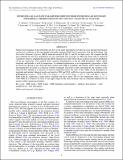INTERSTELLAR GAS FLOW PARAMETERS DERIVED FROM INTERSTELLAR BOUNDARY EXPLORER-Lo OBSERVATIONS IN 2009 AND 2010: ANALYTICAL ANALYSIS
Author(s)
Bochsler, P.; Bzowski, M.; Heirtzler, D.; Kubiak, M. A.; Kucharek, Harald; Lee, M. A.; Leonard, Trevor; Schwadron, N. A.; Wu, X.; Fuselier, S. A.; McComas, David J.; Petersen, L.; Saul, L.; Valovcin, D.; Wurz, P.; Mobius, Eberhard; Crew, Geoffrey B.; Vanderspek, Roland K; ... Show more Show less
DownloadMoebius-2012-INTERSTELLAR GAS FLO.pdf (1.869Mb)
PUBLISHER_POLICY
Publisher Policy
Article is made available in accordance with the publisher's policy and may be subject to US copyright law. Please refer to the publisher's site for terms of use.
Terms of use
Metadata
Show full item recordAbstract
Neutral atom imaging of the interstellar gas flow in the inner heliosphere provides the most detailed information on physical conditions of the surrounding interstellar medium (ISM) and its interaction with the heliosphere. The Interstellar Boundary Explorer (IBEX) measured neutral H, He, O, and Ne for three years. We compare the He and combined O+Ne flow distributions for two interstellar flow passages in 2009 and 2010 with an analytical calculation, which is simplified because the IBEX orientation provides observations at almost exactly the perihelion of the gas trajectories. This method allows separate determination of the key ISM parameters: inflow speed, longitude, and latitude, as well as temperature. A combined optimization, as in complementary approaches, is thus not necessary. Based on the observed peak position and width in longitude and latitude, inflow speed, latitude, and temperature are found as a function of inflow longitude. The latter is then constrained by the variation of the observed flow latitude as a function of observer longitude and by the ratio of the widths of the distribution in longitude and latitude. Identical results are found for 2009 and 2010: an He flow vector somewhat outside previous determinations (λ[subscript ISM∞] = 79[° over .]0+3[° over .]0(–3[° over .]5), β [subscript ISM∞] = –4[° over .]9 ± 0[° over .]2, V [subscript ISM∞] = 23.5 + 3.0(–2.0) km s[superscript –1], T [subscript He] = 5000-8200 K), suggesting a larger inflow longitude and lower speed. The O+Ne temperature range, T [subscript O+Ne] = 5300-9000 K, is found to be close to the upper range for He and consistent with an isothermal medium for all species within current uncertainties.
Date issued
2012-01Department
Haystack Observatory; MIT Kavli Institute for Astrophysics and Space ResearchJournal
The Astrophysical Journal. Supplement Series
Publisher
IOP Publishing
Citation
Mobius, E., P. Bochsler, M. Bzowski, D. Heirtzler, M. A. Kubiak, H. Kucharek, M. A. Lee, et al. “INTERSTELLAR GAS FLOW PARAMETERS DERIVED FROM INTERSTELLAR BOUNDARY EXPLORER-Lo OBSERVATIONS IN 2009 AND 2010: ANALYTICAL ANALYSIS.” The Astrophysical Journal Supplement Series 198, no. 2 (January 31, 2012): 11. © 2012 The American Astronomical Society
Version: Final published version
ISSN
0067-0049
1538-4365